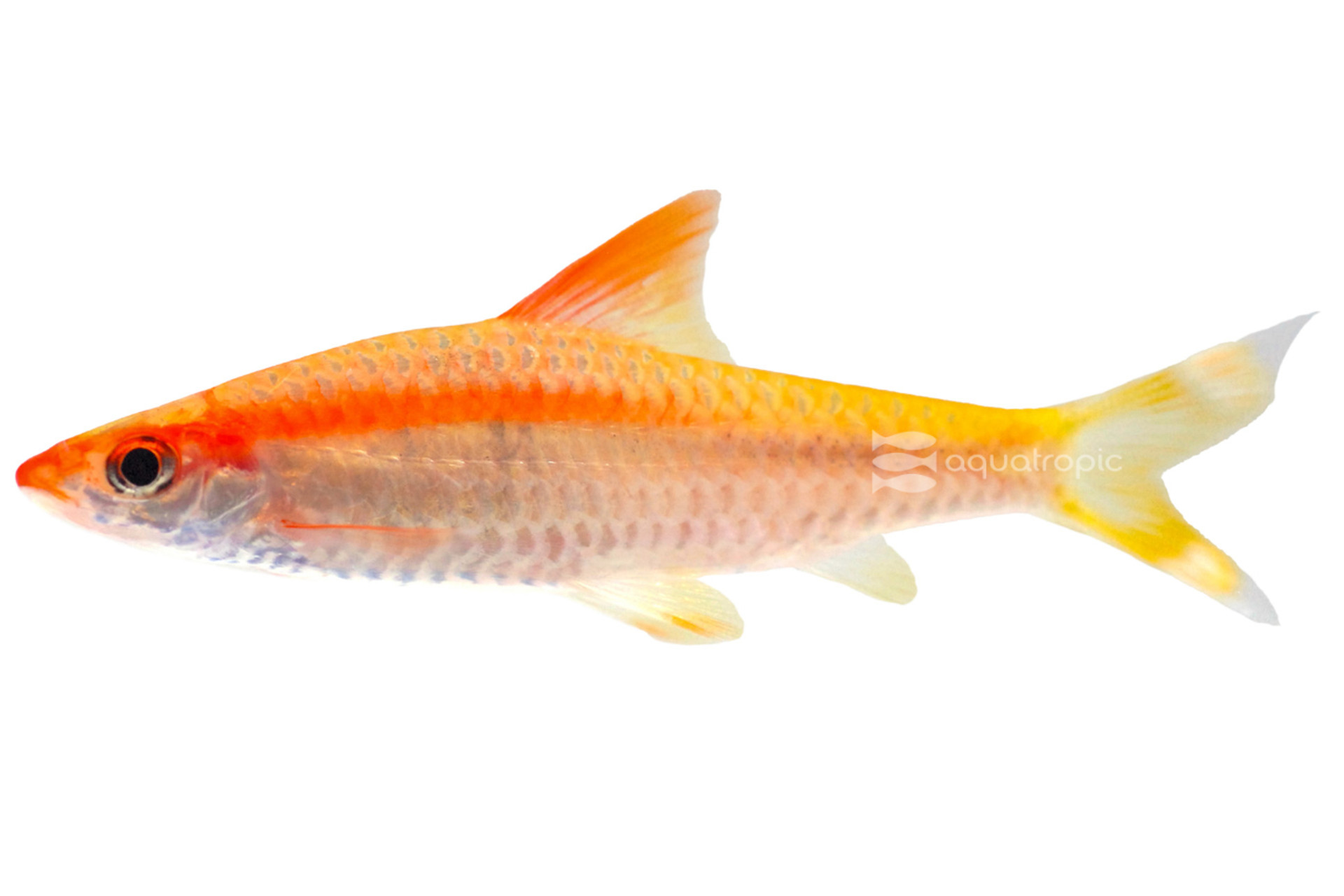The Golden Roseline

The Gold Roseline Denison Barb (Sahyadria denisonii) or sometimes called the Torpedo Barb is a fish from the Carp and Minnow family known as Cyprinidae. They are also sometimes called Roseline Shark, and even less frequently (but maybe more interestingly,) Miss Kerala. All the fish in this family lack an adipose fin, which is the one between the dorsal (back) fin and the caudal (tail) fin. After years of aquaculture, there are more than a few colors of Denison Barb available. The original form wild fish is easily recognized with its shiny silver body, red and black stripe running from nose to tail, red on the dorsal fin, with black and yellow spots on the tail fin. The Gold Roseline base color is a soft gold, and what was the black stripe on the wild fish is now shimmery rose-gold. They are gorgeous.
Sahyadria are active fish that prefer to be kept in schools of at least six, and more is always better. They can also get to be four inches long (rarely a little bigger) and as such, they are going to need a tank that is at least 55 gallons and if you have lots of them, keep sizing up. They are very fast swimmers and have been known to jump (perhaps on accident), so we recommend having a covered display. While they aren't likely to bother your plants much, they like so much flow that most plants will be a challenge in this environment. They will appreciate cover in the way of driftwood and rocks. They won't need a substrate, but if you'd like one for aesthetics, a smooth gravel would be most appropriate.
These wild fish were originally found in the western Ghats mountains of southern India, where they lived in the pools of clear, clean, very oxygenated streams. Even though the Gold Roseline Denisons are aquacultured, they'll still prefer similar conditions in your display. Try to supply them with as much current as possible by utilizing filters that will turn over the volume of the display at least 10 times an hour and 20 would be even better. This will not only help keep the water sparkling clean but will also help keep the oxygenation level nice and high. You could also add further flow and O2 by using air pumps and sintered stones.
Denison barbs can tolerate a wide range of temperatures and hardness levels in the aquarium. You could keep them in tanks as low as 68 degrees and up to 78 degrees, and the hardness levels could be just about anything. They will do best in a mostly neutral pH, in the 6.5 to 7.5 range would be perfect. The one thing that Gold Roseline Denison Barbs will not handle well is high nutrient loads. Strive to keep your nitrates under 5ppm. We've already gone over the oversized filtration portion of this equation, but you should also plan for large, regular water changes which will further enhance the cleanliness, clarity and oxygenation of your display.
Gold Roseline Denison Barbs are peaceful fish which will fare well in a larger community aquarium, the one caveat to this is that these Barbs are fast swimmers who aren't shy at mealtimes, and so care should be taken with smaller, more timid tank mates that could be out competed for food. Good tank mates start with more Denison Barbs and they don't all need to be the same coloration to shoal together. They will generally cohabit well with other fast, friendly fish like Danios, Rainbowfish, more peaceful Cichilds, Plecos and other Armored Cats.
Pretty much all the fish we label as Barb are easy to feed, and this applies to Gold Roseline Denisons very well. They will take pretty much anything you feed them, and here they get a mix of thawed foods from Gamma and sinking Freshwater Complete pellets from Nutramar. We change up the meaty foods, but they often include mysis, bloodworms, brine, and tubifex. They will also happily take appropriately sized live foods.
Not too much is known (or at least published) about the reproduction of Denison barbs in captivity, and having it happen in the home aquarium is very rare. Commercial reproduction happens in a rigorously controlled, intense aquaculture setting. With that being said, there are sporadic reports of them spawning in public and private aquaria. This generally occurs in softer water, with large groups of fish in large aquariums. Some people claim to have spawned small fish and noticed fry in their aquariums, but these reports are difficult to corroborate. When trying to sex your fish, the females would tend to be larger than males, but otherwise identical.
Gold Roseline Denison Barbs are a medium sized, but very showy schooling fish that are a great choice for freshwater community aquariums that are big enough to support the number you choose. They do well with most other fish that can keep up with them, and if given an appropriate environment, are very durable. If you're looking for a fish that brings that Tetra-like activity in a bigger size and gorgeous color, then this is a variant of Sahyadria denisonii that you might want to consider. Head to your Local Fish Store and ask them about getting you some Gold Roseline Denison Barbs from Aquatropic today! Or if you want a mixed batch of them, as of the writing of this article, we regularly stock four other color forms of Sahyadria denisonii so, maybe you want to look into those as well!